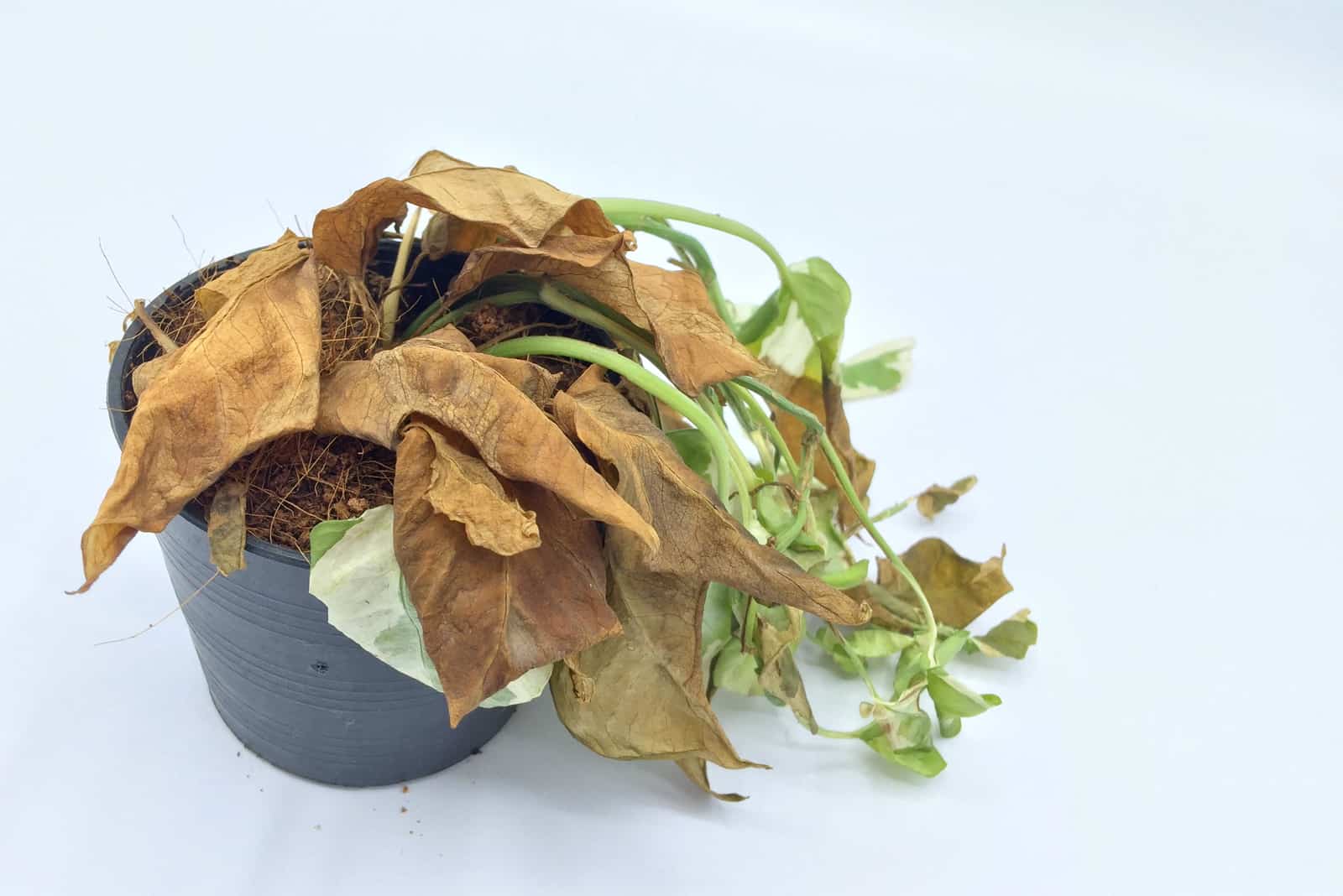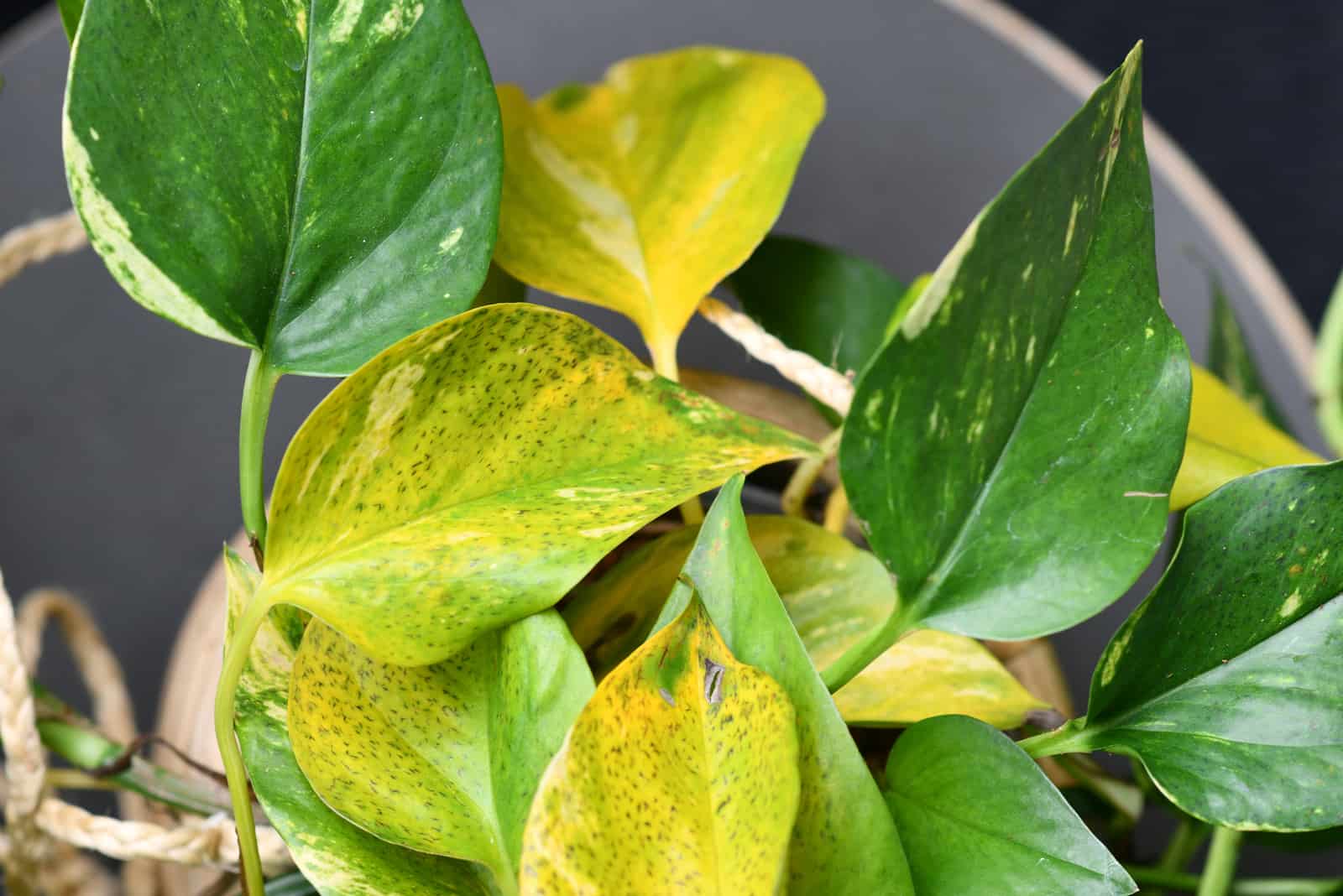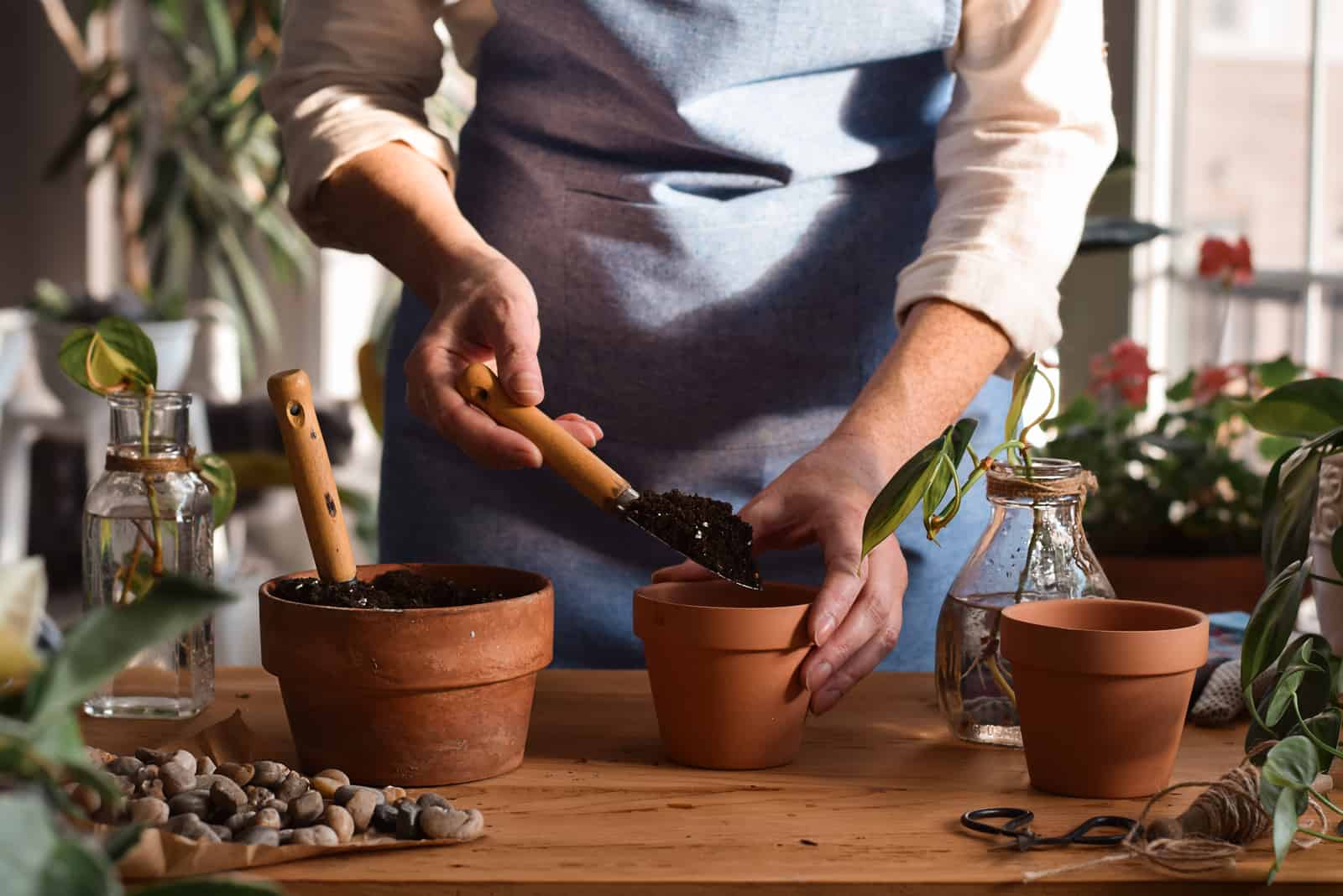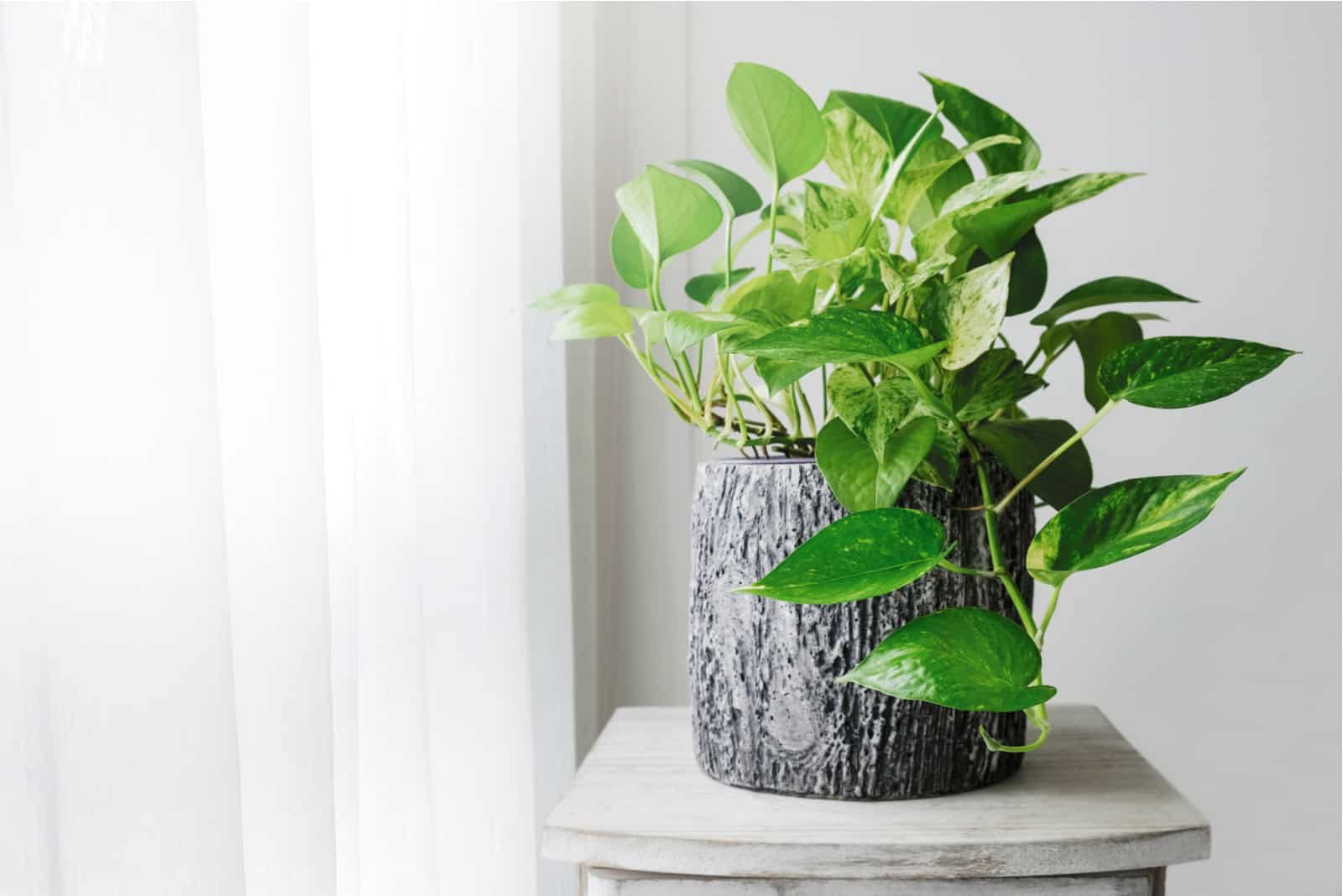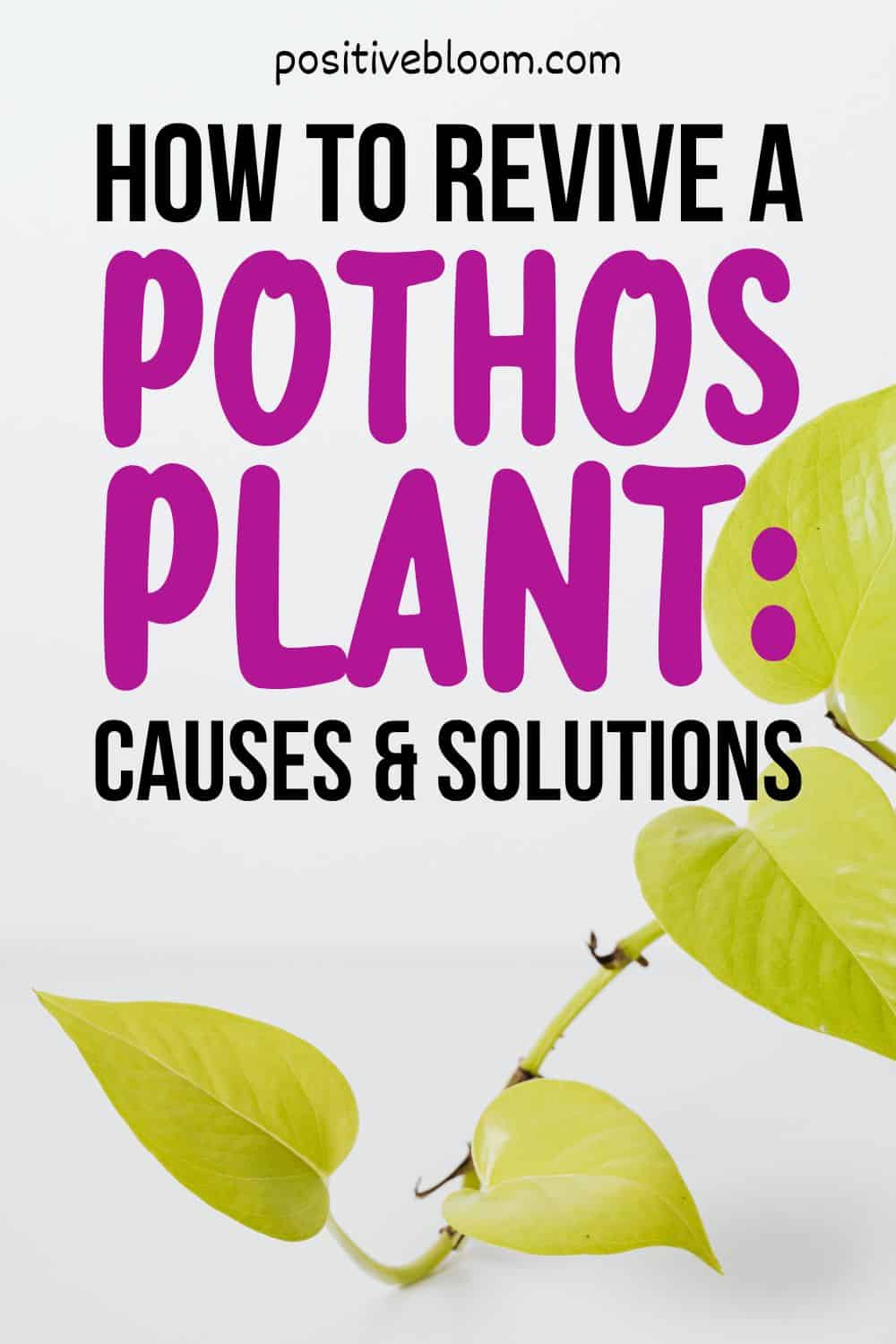With their long vines and beautiful heart-shaped leaves, the pothos is definitely one of the most aesthetically pleasing houseplants. It can fit any type of home decor, especially if you are aiming for a perfect, clean, and minimalistic style!
They are also known for being low-maintenance plants that purify the air and remove toxins from it.
However, if you notice that their long vines are slowly wilting, the leaves are yellowing, and it looks like the plant is dying, there is something you can do to save it!
Even though the pothos plant is low-maintenance, you can’t just leave it on its own — you still have to provide it with optimal conditions for it to grow and develop. If its needs aren’t met, your pothos will slowly start to die.
Read on to find out how to revive a pothos plant, and also what might be the cause of its wilting.
Reasons Your Pothos Might Be Dying
When taking care of any type of plant, it’s important to know its basic requirements. This refers to its watering needs, lighting conditions, fertilization, soil requirements, etc.
This is why it is important to create a special plant care guide for your plant, and stick to it!
Otherwise, you will be left with a wilting and dying plant.
If you are dealing with a dying pothos, you might notice:
• Yellow leaves
• Droopy leaves
• Stunted growth
• Brown spots on the leaves
• Soil starting to smell
• Leaves starting to fall off
• Wilting
Let’s look at the reasons your pothos plant might be dying.
1. Overwatering
Pothos are tropical plants native to deep rainforests, and have adapted to constantly moist soil. As a result, they require frequent watering.
While maintaining high soil moisture levels is crucial, there is a chance that you can go overboard, and your plant may become waterlogged if you give it too much water.
If this occurs, air can’t get to your plant’s roots, so your precious houseplant won’t be able to absorb nutrients normally. In fact, you’ll suffocate your plant!
In addition to providing your plant with a lot of water, a few other factors can also lead to overwatering. Temperature, poor drainage, soil mix, and humidity levels are other significant factors that contribute to the watering needs of your pothos!
For example, during the summer you will need to water your plant much more regularly because the soil dries out and the water evaporates quicker. During the winter you need to consider humidity because the air becomes drier and you will need to mist the plant’s leaves.
Yellowing of the foliage and general plant withering are typical signs of an overwatered pothos plant. Find the ideal watering schedule and use the right potting mix to prevent overwatering. It is also important that you grow your Pothos in a pot that has drainage holes in the bottom to let the excess water drain.
Root Rot Due To Overwatering
The most vital component of your plant, the roots, are the first thing in the firing line of the deadly fungal infection known as “root rot”.
Before you realize it, this pathogen will completely devastate your plant.
Root rot is usually an outcome of prolonged overwatering because this fungus thrives in soggy soil. If you notice any nasty smell coming from the soil, in addition to leaves that turn yellow, you are probably dealing with root rot.
Repotting is required to save your plant in this situation!
2. Underwatering
As we previously mentioned, your Pothos plant, also known as Devil’s ivy, thrives in moist soil. This means that if you don’t give it enough water for an extended period, the leaves will start to curl up due to water deficiency.
Lack of water will lead to soil pulling away, dead leaves falling off the plant, and discoloration of the leaves. These are the usual signs of a dying pothos due to underwatering.
Pothos plants can grow in a wide range of environments, and even without water. If they don’t get water, they won’t keep their healthy leaves and the heat will force them to lose water even more, which will make the leaves curl and turn brown.
This mostly happens in the summer when the combination of lack of water and extreme heat causes the plants to become increasingly thirsty and dry up.
For a plant to flourish and maintain its viability, water is a must. To prevent soil dryness, the pothos needs regular watering.
3. Too Much Or Too Little Light Exposure
The healthy growth of this plant depends on it getting the right amount of light. The majority of houseplants require the same amount of light, however, some can tolerate higher or lower levels.
It’s a little bit different with pothos plants.
The thick trees in deep rainforests prevent plants from receiving direct sunlight.
The pothos plant needs 8 to 10 hours of indirect, bright light each day. This supports their ability to conduct photosynthesis, maintain variegation, and provide a sufficient supply of nutrients and water.
The plant cells required for photosynthesis are harmed by direct sunlight. There is no possibility for recovery if the plant is exposed to direct sun for an extended period of time because the pothos leaves will be crispy and damaged.
Low light will also have a negative impact on your pothos and prevent photosynthesis, so the entire plant will appear to be wilting.
Both direct and inadequate light can harm these plants as they require intense indirect light.
Fortunately, it’s simple to determine whether light is the reason your plant is dying. Because leaves develop or expand toward light sources, your pothos leaves are probably not getting enough indirect sunlight.
4. Pest Infestation & Fungal Diseases
Dry vines on trailing pothos and damaged leaves might be the result of a pest infestation. Though this plant is perfect for beginner gardeners because it isn’t prone to pest infestations, things can still get messy with the ones they are susceptible to!
Many pests typically settle under the leaves of pothos plants. Mealybugs and spider mites are the two most common pests and might be damaging your pothos plant, particularly if pests and insects are behind freshly emerging leaves.
All the nutrients necessary for healthy leaf growth are sucked out by pests and insects who feed on plant sap. The food flow from the stem to the leaves may be totally cut off if the infection is severe, which causes the leaves to droop and curl.
Pests can be easily removed using rubbing alcohol, insecticide, or neem oil directly on the site of the infestations.
When it comes to fungal diseases, if you notice any white spots on stems and leaves, then you are probably dealing with a fungal infection. In addition to root rot, you might also notice white strands of fungal mycelia on the potting soil, which usually spreads to your entire indoor plant collection.
These can be treated by repotting into a new pot, and also by using fungicide or neem oil.
5. Inadequate Temperature
Inadequate temperature is a common cause of your plant’s leaves curling and falling off. High temperatures might help your pothos thrive, but anything above 110 degrees Fahrenheit will negatively impact the plant, and can even be lethal if left unchecked.
The plant’s leaves will curl to protect themselves from the heat when kept at high temperatures. Their surface area for photosynthesis is likewise decreased as a result.
When leaves are exposed to extreme temperatures, they are unable to perspire and eventually become dehydrated because the heat lowers moisture. Thus, your plant will experience similar symptoms to underwatering.
You should also keep in mind that the pothos is a tropical plant, which means that it doesn’t like low temperatures either. Brown leaves are usually a sign of cold damage, and cold drafts from open windows are usually the reason for them.
6. Low Humidity Levels
There is high humidity in the deep forests pothos originate from. This means they like higher humidity levels, so keeping them in dry air will only lead to stunted growth and deterioration.
The soil will lose water more quickly in conditions of low humidity or dry air, and as a result the leaves won’t have access to water and curl in an effort to hold onto as much moisture as they can.
If the potting soil is dry, the plant needs more humidity, but it will also appear to be wilting, dull, and lose its variegations (if you are growing a variegated variety, such as Hawaiian pothos).
7. Overfertilization
Giving your pothos a little plant food is a good way to boost new growth and development, but you can overdo it.
If you give your pothos too much plant food its leaves will start to curl, droop, and turn yellow.
Despite the fact that fertilizer promotes a healthier, faster rate of growth for the plant, overfeeding or continuous feeding will have the opposite effect. This is because each plant needs a certain ratio of potassium, phosphorus, and nitrogen in addition to a precise amount of fertilizer.
Overfeeding your pothos plant will result in a concentration of salts and nitrogen that is detrimental.
Giving your plant a boost to speed up its metabolism is what fertilization is all about, while overfeeding actually entails forcing its metabolism to function.
The nutrients will be delivered to the leaves more quickly through the roots at first, however, this capacity will gradually decline with time because too much fertilizer will make the roots stop working.
8. Bad Potting Soil
Pothos plants thrive in loose and well-draining soil that doesn’t retain excess moisture. If the soil is too compact, the water will not drain properly and you will end up with mushy roots on a wilting plant.
Another issue with compact soil is aeration — oxygen needs to travel through the soil to reach the plant’s roots, which is why we mostly use porous soil. However, in compact soil, normal airflow is prevented and your plant has no access to oxygen.
Therefore, the wrong potting soil can affect the normal workflow of the root system and lead to overwatering.
9. Wrong Pot Size
Imagine being in a room where you can’t move your arms or legs very much — this is how your plant feels when it is growing in a small pot!
When you give your plant food and water it will grow, and this includes the roots. Once your plant stops growing, you should immediately check if the roots are coming out of the drainage holes.
If they are, then the root ball of your plant has probably filled out all of the empty space in the pot, and now the roots have nowhere to go!
You should immediately repot your plant into a new pot that is a bit larger than the previous one in this case.
How To Revive A Dying Pothos Plant
All is not yet lost, and you still have a chance to fix these problems and nurture your precious plant back to life.
Once you’ve figured out the reason your pothos is dying, you can fix it and your pothos will look as good as new!
In case your plant has gotten to the point when it can no longer be revived, always look for leaves and stems that can be used for propagation and start growing the plant from scratch.
1. Use The Right Potting Soil
Pothos plants require soil that drains efficiently in order to prevent excessive moisture retention. Choosing the right soil is crucial because too much water in the soil can lead to root rot.
Excess water will be drained by proper soil mixture and drainage holes in the bottom of the pot. You can create your own aroid mixture or buy one from the store.
Perlite, universal soil mix, vermiculite, and peat moss can all be combined to create the perfect potting mixture. You can also use potting soil for philodendrons, succulents, and cacti.
2. Create The Perfect Watering Schedule
Beginner gardeners frequently search for a clearly defined watering schedule, but in most cases a regular schedule won’t guarantee your plant gets enough water. Overwatering is a serious problem that can result from a regular watering schedule.
Generally speaking, water the pothos every five to seven days, but always examine the soil thoroughly before watering.
The pothos species requires moist soil, and it will wilt and develop crispy leaves if the soil is allowed to completely dry out between waterings. When your pothos plant gets thirsty, the leaves will curl inwards. Give your pothos a good watering if you notice any of these changes.
I recommend you create your own watering schedule by monitoring the plant and regularly inspecting the soil to see whether it needs to be watered.
Before watering, let the top 2 inches of soil completely dry out. The simplest method to check for soil moisture is to stick your finger in it. Alternatively, you can use a wooden stick or a toothpick. If any soil remains after you remove them, you should wait a bit longer before watering your pothos.
You shouldn’t water your pothos as frequently during winter because it enters dormancy and doesn’t require a lot of nutrients or water.
3. Remove Dead Roots
Once root rot has set in it is difficult to treat, and the plant can only be saved by removing the dead parts (including the roots) and repotting in new soil.
If the root rot is severe and has affected the plant’s entire root system and leaf canopy, it might not be possible to save it.
The methods listed below can be used to revive your pothos if it still has some healthy roots:
• Check the roots by removing the soil from the pothos. Break off as much soil from the roots as you can before gently removing the plant from the pot. Look for any rotting spots on the plant’s roots and leaves. While healthy roots are strong and green or white, decayed roots are black, mushy, or stringy.
• Use sterile scissors or pruners to prune any rotting roots and foliage. Take care not to harm the plant’s healthy parts. Sterilize your tools to stop the infection from spreading.
• Repot your pothos. After removing all of the dead or dying roots and foliage, repot your plant in new soil. Consider the potting mix you use carefully and choose a pot with drainage holes. It must drain adequately because poor drainage will cause the process to reverse. The potting soil should also be able to hold water well because it requires moist soil to develop properly.
4. Adjust The Temperature
Pothos are tropical plants, which means they do best in warm climates.
You should be aware that pothos plants can survive in temperatures between 55 and 85 degrees Fahrenheit, though they prefer to be between 70 and 90 degrees.
Any lower or higher temperature than this would be unhealthy for your pothos.
5. Increase The Humidity
Ideal humidity levels for pothos plants are between 70 and 80 percent. Here are some ideas for boosting humidity levels if you are having trouble doing so:
• The safest, but not the cheapest option, is to get a humidifier. You can choose the preferred range and the duration of activation by setting a timer. There are various options available on Amazon.
• The plants could also be grouped. Plants expel moisture through their leaves in a process called transpiration. In order to create a more favorable microclimate, plants can be clustered together to benefit from each other’s transpiration.
• By placing your plant on top of a tray with pebbles and water, you can create a homemade pebble tray to keep the plant moist. Your plant will receive the moisture it requires as the water evaporates, just be sure the roots don’t touch the water.
• Use a spray bottle with clean water to mist the plants. Misting is especially helpful at the beginning of winter because humidity quickly drops as the temperature drops.
6. Change The Lighting
Variegated plants may lose their leaf pattern and develop completely green leaves if they don’t receive enough light. Fortunately, fixing issues with light is simple.
To guarantee your pothos receives enough light, position it beneath a lamp, in a hanging basket near a window, or on a windowsill that doesn’t receive direct sunshine.
Moving your pothos away from windows or any other light source will help if it has been receiving too much light. However, you should use sheer curtains to provide some partial shade if you want to position this plant close to a window that receives direct sunlight.
7. Use The Right Amount Of Fertilizer
First, you must determine the level of fertilization that your plant has been dealing with.
If you have only been slightly overfertilizing, no drastic steps are necessary; just stop giving your pothos plant any nutrients for a few months.
Start feeding the plant in small quantities that progressively increase as the plant grows once it has returned to normal.
On the other hand, you should uproot your pothos plant and brush away all of the soil around the roots if you were using substantially more fertilizer than was necessary. Your pothos plant needs to be repotted after this.
Pothos have a straightforward fertilizer regimen because they require minimal care. To prevent burning your pothos, apply an all-purpose indoor plant fertilizer once or twice a month and dilute it to half strength.
8. Propagate Your Plant
If your Pothos plant has gotten to the point where it can no longer be saved, all you have left is propagation.
The two most frequently used methods are root and water propagation.
Water Propagation
Given that root growth can be observed in the water, this method is more common than root propagation.
1. Start by looking for a healthy stem with leaves and cutting it to a length of around 5 inches.
2. Add water to the stem cutting. Use a glass, jar, or vase.
3. Keep it in light shade.
4. The establishment of roots will take around a month. After this, you should put the cutting in soil.
Root Propagation
When repotting or pruning, you can propagate your Pothos by roots at the same time. It has to be transplanted into a new container using stem cuttings.
1. Select a sturdy stem with at least four leaves and trim it to a length of about 5 inches.
2. Though it’s not required, you can dip the cutting in a rooting hormone.
3. Ensure that the potting soil has already been prepared.
4. Make sure to keep the cutting at its optimal temperature and avoid exposing it to any direct sunlight.
For clearer instructions about propagation, check out this video:
9. Get Rid Of Pests
Even though these annoyances are not visible to the naked eye, they can create serious problems for your plant, and even kill it.
I would suggest you first investigate the plant thoroughly so you can be sure that you are really dealing with pests — you don‘t want to use pesticides or any type of bug repellants if you don’t have to.
There are several options that you can use to get rid of pests. The easiest would be to use pesticides or insecticides, however, you can also go organic and apply neem oil, dishwasher soap, or even rubbing alcohol.
Garlic, neem oil, soap/dishwasher liquid, or any other natural repellent should be diluted with water before being sprayed on the pothos leaves.
To Sum Up
If your pothos is dying, don’t lose hope!
You can still do lots of things to save your precious trailing plant, and it can thrive and grow again. Even though these plants are low-maintenance, you still have to provide them with optimal conditions if you want to keep them happy and healthy.
It is important to determine the issue first, then go through our section on how to revive a pothos plant to learn how to fix it.
If your plant has gone as far as it can, you can still look for healthy leaves and try propagating them to grow a new pothos from scratch — but this time, make sure to keep them in indirect sunlight, water once the topsoil has dried, and fertilize once or twice a month.
I hope this article was helpful. 🙂
Until next time!
Like this post? Share or pin it for later!

